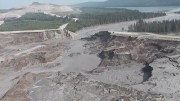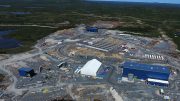The following is the abridged summary of the Mining Association of Canada’s 112-page report titled “Facts & figures of the Canadian mining industry 2014,” which was released in early February and is available at www.mining.ca.
The mining industry contributes greatly to Canada’s economic strength. The industry employs more than 380,000 workers across the country in mineral extraction, smelting, fabrication and manufacturing. Proportionally, the mining industry is also the largest private sector employer of Aboriginal Peoples in Canada and employment is poised to increase. The industry’s $54-billion contribution to Canada’s gross domestic product in 2013 included $22 billion in mineral extraction, and $32 billion in mineral processing and manufacturing.
Internationally, Canada is one of the leading mining countries and one of the largest producers of minerals and metals. The industry accounted for 19.6% of the value of Canadian goods exports in 2013, selling a diversified array of minerals abroad. Exports of aluminum, copper, gold, iron and steel, iron ore, nickel, silver, uranium, zinc, diamonds, potash and coal ranged from $1.5 billion to $17.7 billion each.
Canada slipped from the world’s top destination for exploration spending in 2012 to the second spot behind Australia in 2013. Canada’s percentage of global mineral investment dropped from 18% in 2011 to 13% in 2013, which indicates the fierce competition for global mineral investment. Canadian exploration spending is focused in many regions, with a strong interest in the North.
More than 800 Canadian companies are also active exploring outside of Canada in over 100 countries.
While mining is important to Canada at the local community level, it also contributes to the economies of large cities. Toronto, for example, is the global hub for mining finance. The Toronto Stock Exchange and TSX Venture Exchange were home to 57% of the world’s publicly listed mining companies and traded more than $200 billion of mining stock in 2013. Together, the two exchanges handled 48% of global mining equity transactions in 2013, and accounted for 46% of global mining equity capital that year. Vancouver features the world’s leading cluster of exploration companies, while Montreal is home to major aluminum and iron ore firms. Edmonton has become a global centre for oilsands expertise and Saskatoon for uranium and potash.
Other evidence of the industry’s vast economic reach is that mining accounts for over one-half of all rail freight revenues of Canada’s major railways: CN and CP. As well, more than 3,400 suppliers provide expertise to the industry, making indirect economic contributions across Canada.
A recent survey commissioned by the Canadian Association of Mining Equipment and Services for Export indicates that 913 companies in Ontario alone identify as mining suppliers. Together, they provide 68,000 more jobs across the province, and generate 1% of provincial gross domestic product and $1.5 billion in government tax revenue.
Mining and its related industries are important contributors to federal, provincial and territorial coffers. According to a recent Mining Association of Canada (MAC) study, the industry’s payments to governments totalled $71 billion in taxes and royalties over the decade leading through to 2012. Beyond contributions to governments, the average annual pay for a mining worker in 2013 exceeded $110,000, which surpassed the average annual earnings of workers in forestry, manufacturing, finance and construction by a range of $31,000 to $46,000.
In 2013, Canadian mining companies invested $522 million in research and development (R&D). Mining’s investment surpassed that of the motor vehicles and parts sector, and the wood products and paper sector. In 2012, the most recent year for which data is available, the industry employed over 4,700 people in R&D. This is more than the pharmaceutical and forestry sectors, both of which receive extensive financial and policy support from the government.
Key issues for Canadian mining
According to recent MAC research, there are upwards of $160 billion in potential mineral project investments over the next decade in Canada. This would translate into multiple billions worth of investments in most of Canada’s provinces and territories, namely B.C., Alberta, Saskatchewan, Ontario, Quebec, Newfoundland and Labrador, Nunavut and the Northwest Territories. These projects may face obstacles and delays, but the figure does suggest the scale of mining-related jobs, supply contracts and tax revenues if these projects come to production. The future of these projects is shaped by many issues, domestic and global, of which five are particularly relevant.
State of the global mining economy — Like our nation’s economy, the Canadian mining industry is not immune to global economic trends. The profitability of companies depends in part on the performance of commodity prices, which are subject to market volatility and driven by global supply and demand. At the outset of the economic recovery, mineral prices increased and remained at favourable levels, despite volatility, through to 2013. Recent uncertainty over the short-term global economic outlook — such as concerns over eurozone contagion, the softening of Chinese growth, uncertainty over the strength of the U.S. economic recovery, and increased supply for some commodities — caused the buoyant mineral prices of some mined goods to decline in 2014.
Despite challenges, the prevailing view is that the Canadian mining sector’s economic prospects remain strong over the medium- to long-term. Given the long-term growth projections for China, India and other emerging countries, and assuming a positive investment environment, demand for minerals and metals is likely to stay strong. This is especially true as the consumption patterns of middle-class developing economies come to resemble those of industrialized countries.
Canadian investment competitiveness — While elements of Canada’s mining tax regime are attractive, recent changes from the 2012 and 2013 federal budgets will make it more costly for companies to both develop projects and expand mines. This is particularly true for remote and northern regions. Innovation and productivity also impact Canadian competitiveness, and the industry faces several challenges in this regard. Challenges discovering new deposits, operating deeper mines, rising energy costs and increasing regulatory requirements are all obstacles that need to be addressed. The OECD has indicated that lagging productivity is one of Canada’s biggest economic hurdles. In response to these challenges, the Canadian Mining Innovation Council (CMIC) was formed with the aim of investing mining industry R&D dollars more strategically. The Canadian government can help the industry overcome these challenges by ensuring that Canada remains attractive for mining investment, and that CMIC receives the funding it needs to build a portfolio of projects that reflects the industry’s innovation needs.
Canadian regulatory burden — New mines and major expansions must undergo federal reviews and approvals in addition to the review and permitting requirements of their provincial or territorial jurisdiction. Most major mining projects in provinces are subject to the Canadian Environmental Assessment Act as well as parallel provincial assessments and, depending on the details of the project and the mine site, they may require approvals under other federal legislation, such as the Fisheries Act and the Navigation Protection Act.
All three federal acts were amended in 2012, and amendments have come into force at varying times in the years that followed. A review of the Metal Mining Effluent Regulations was also announced in 2012 and is still ongoing. The full impact of these legislative changes and their consequences remain unknown. It is expected that once fully implemented, there will be an increase in the number of federal approvals required and in the number of mining projects subject to federal environmental assessments.
In addition to the uncertainty created by these legislative changes, industry is concerned about inadequate coordination within the federal government and between federal and provincial processes. The Canadian Environmental Assessment Agency and key departments — such as Environment Canada, Fisheries and Oceans Canada and Transport Canada — must work together to ensure mining projects are reviewed once, and that the various federal requirements, along with aboriginal and public considerations, are integrated into a unified, robust and timely process with meaningful consultation.
Need for strategic infrastructure investment — The mining industry is the largest customer group of Canada’s transportation sector. It is, therefore, important that the sector moves products to market efficiently, at competitive prices and on modern infrastructure such as ports, highways and railways. Capital spending opens up new regions for development by enhancing the economic viability of a host of projects. Conversely, Canada’s vast geography, and the substantial cost required to overcome it, can be a barrier to developing remote and northern mining projects.
Mineral investment can help governments and communities achieve public social and economic policy objectives for these regions. As such, MAC recommends the government seriously consider the means at its disposal to advance this nation-building opportunity, specifically tax incentives, infrastructure investments and public-private partnerships.
The human resources challenge — According to the Mining Industry Human Resources Council (MiHR), the Canadian mining industry will require 121,000 new workers over the next decade. This deficit is compounded by the approaching retirement of the industry’s skilled core of workers. By 2024, MiHR forecasts more than 53,000 employees will retire from the sector. As Canada’s largest private sector employer of Aboriginal Peoples on a proportional basis, the industry is in a good position to increase aboriginal employment if the right training and skills programs are developed and maintained. Approximately 1,200 aboriginal communities are located within 200 km of some 180 producing mines and more than 2,500 active exploration properties. Addressing the human resources challenge will take a large and coordinated effort by the industry, educational institutions and all levels of government in the coming years.




Be the first to comment on "Facts ‘n’ figures – MAC: Counting mining’s contribution to Canada"